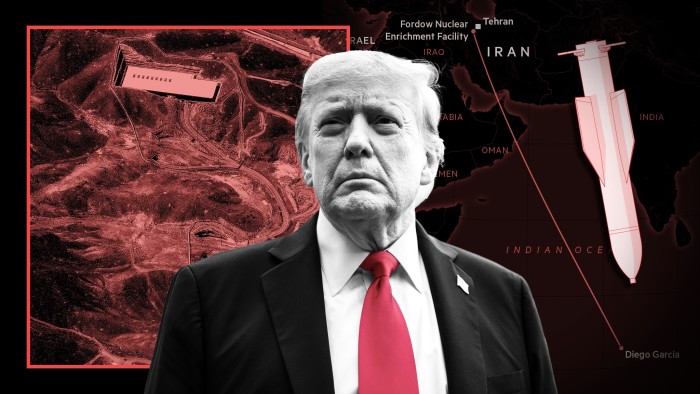The USS Nimitz, one of the US’s 11 nuclear-powered aircraft carriers, abruptly changed course on Monday, powering away from the South China Sea towards the Middle East as Israel’s bombing campaign in Iran intensified.
The Nimitz carrier strike group — made up of the aircraft carrier and three missile-guided destroyers — will join one strike group and multiple destroyers in the region. It will take about a week to arrive, said a US defence official.
The deployment of the colossal vessel is among the clearest signals that President Donald Trump is contemplating joining Israel in attacking Iran, and throwing America’s military into another war in the Middle East.
In the US’s — and Israel’s — sights is Fordow, the underground uranium enrichment facility buried deep inside a mountain and encased in concrete near the ancient Iranian city of Qom.
Despite the damage Israel’s defence forces have inflicted on Iran in recent days they have neither the bombs nor the planes needed to strike Fordow.
But the US has the 30,000lb bunker-busting GBU-57 Massive Ordnance Penetrator bombs and the stealth B-2 bombers that can carry them, likely to take off from the UK-US base on the Indian Ocean island of Diego Garcia some 5,200km away.
Any US bombing raid deep into Iran is fraught with peril, and would need days of planning and advance positioning of materiel and personnel, said military experts, including fighter jets to fly alongside and protect the B2s.
“There are fairly significant but not insurmountable logistics” for the Pentagon and Centcom, said retired four-star general Joseph Votel, former commander of US Central Command, which is responsible for military operations in the Middle East, from 2016 to 2019.
“In order to deliver this thing, we have to make sure that we’re operating in an environment where we kind of control all the variables where air defence systems of the Iranians or electronic warfare, things can be suppressed,” he told the Financial Times.
Votel said the US would likely get four or five B-2 bombers to the base on Diego Garcia, given its relative proximity to the target location, and its long runway. This would be enough aircraft to carry out the mission and have readily available backup.

Should the US decide to go ahead and strike Fordow “we want to make sure that we’re going to be successful in it”, Votel added.
But he acknowledged “the president might be ready to go” before the carrier strike group arrives. Trump on Wednesday hinted he could be ready to attack Iran within days, saying “the next week is going to be very big”.
The US has 19 B-2 bombers in its fleet, and about 20 GBU-57 bombs, said Mark Cancian, a former Pentagon official now a senior adviser at the Center for Strategic and International Studies think-tank. Each B-2 bomber can carry two bunker-busters.
One bomb would likely be enough to strike Fordow, according to Cancian, but he suspects the US “would use three or four just to be sure”. Other experts say it would take at least two bombs hitting the same spot with pinpoint accuracy.
If deployed, the B-2 bombers would be escorted by other aircraft, including some outfitted with GPS- or laser-guided munitions to ensure any of Iran’s remaining or reconstituted electronic warfare systems could be destroyed.
Another essential component would be mid-air refuelling aircraft that could fill up American or Israeli planes ahead of any potential direct involvement. The Pentagon has ordered dozens to head to Europe from their US bases.
Washington would also need to deploy search and rescue crews in case one of its bombers was shot down or malfunctioned. It would also want to ensure its intelligence resources were battle ready, including space-based systems or satellites that could conduct assessments without the need for personnel on the ground.
The US would likely ensure special forces units were also ready to carry out precision covert ground operations such as penetrating or blowing up certain access points, said missile defence expert Tom Karako, also at CSIS.
However, Votel said the Israelis would be well positioned to conduct such operations themselves.
US bases in the region would need to be at their maximum readiness level in case Iran retaliated against any American strike, Karako added.
“If they have air defences or missile defences, they are queued up, and they’ve got the indications and warning, and everybody’s on razor’s edge . . . so that if and when Iran is able to pop something off they’ll be taken care of,” he said.

Ahead of any strike, the US would get its force protection assets in place “to make sure that in the event that we did become kind of a direct combatant in this and drop weapons that we were doing everything we could to protect our forces . . . Iranians couldn’t lash back out against” US military or diplomatic locations in the region, Votel said.
Bases in the Middle East would have to work with the air defence and ground-based systems they have already — including Himars multiple rocket launchers — because getting other weapons in place would take too long.
Votel expects General Michael Kurilla, the Centcom commander, would want all possible resources in the region ahead of any strike, and would likely advise Trump to wait until they were in place.
A strike on Fordow would be “a big step that I’ve obviously contemplated for a long time and which could have some significant ramifications”, he said. “So I think there’s a good case to be made for more resources into the region.”
Read the full article here




